ASUS Zenbook Prime (UX21A) Review: The First of the 2nd Gen Ultrabooks
by Anand Lal Shimpi on May 22, 2012 2:46 PM EST- Posted in
- Laptops
- CPUs
- Asus
- Ivy Bridge
- Zenbook
- Zenbook Prime
- Ultrabook
- Notebooks
GPU Performance
Peak synthetic GPU performance sees a sizeable boost compared to the previous generation Zenbook. 3DMark 11 requires DX11 hardware and thus the original Zenbook won't run on it, but the rest of the 3DMark tests give us some perspective.
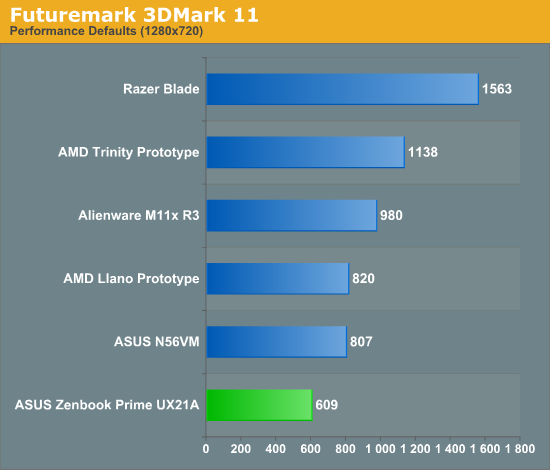
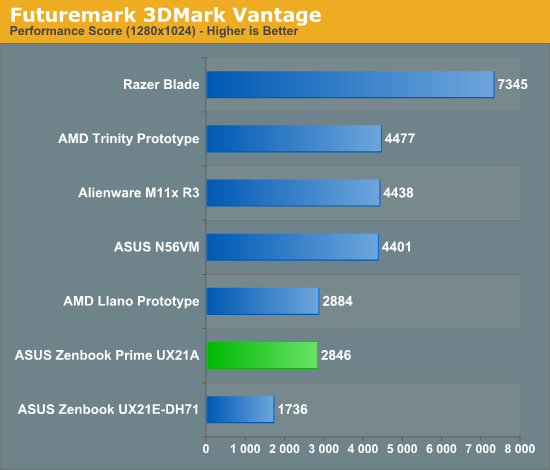
Vantage shows us a 63% improvement over the HD 3000 based Zenbook UX21.
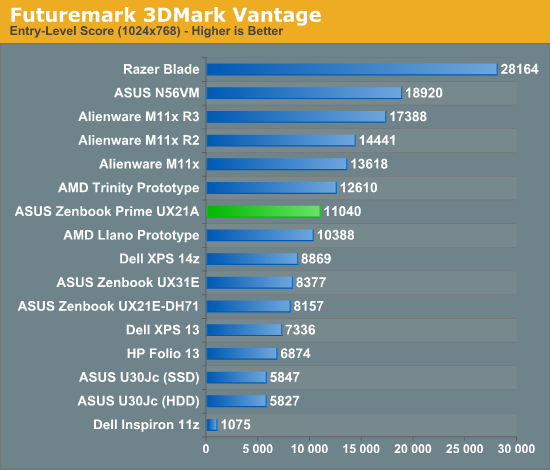
Here we see just how much better Intel's graphics cores have gotten over the years. The Inspiron 11z could barely run the entry level 3DMark Vantage suite, whereas the Zenbook Prime delivers nearly an order of magnitude higher score here.
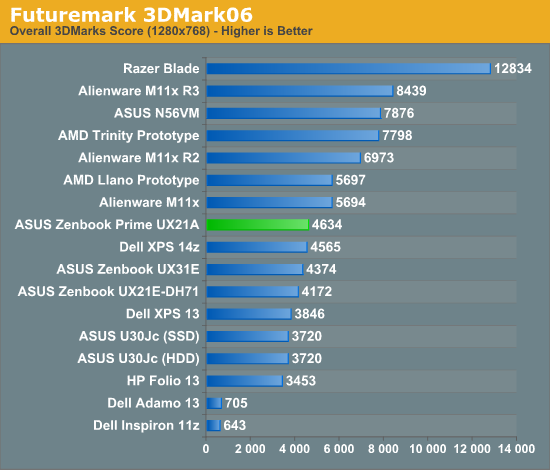
Gaming Performance
We can say that the silicon in the Zenbook Prime's CPU features Intel's HD 4000, the upgraded 16 EU Ivy Bridge GPU. The result should be much improved gaming performance. Once again we are thermally limited so there are some cases where you won't see tremendous increases in performance.
At a high level, for any modern game, you shouldn't count on being able to run it at the Prime's native 1080p resolution. You need a discrete GPU (or Haswell) to pull that off. The former is a tall order for a machine that's already mostly battery. The good news is that 1366 x 768 is playable in many games.
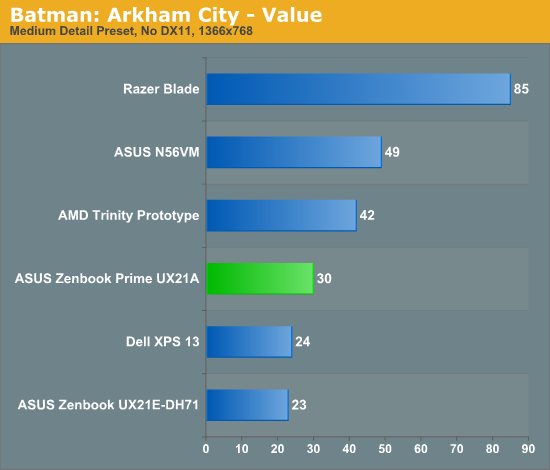
Not all games will see huge performance gains, but the latest Batman title runs 30% quicker on the new Prime.

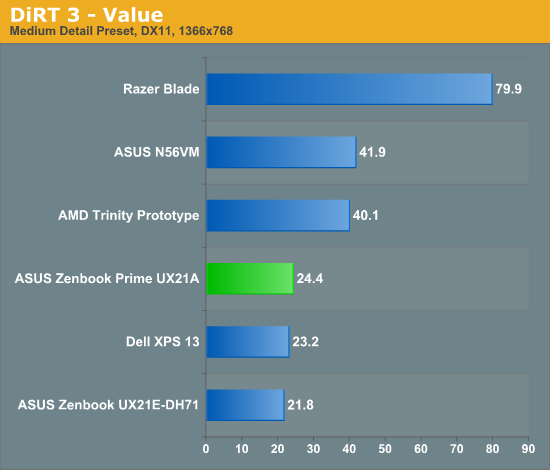
More CPU constrained and thermally bound environments won't show any improvement over the Sandy Bridge based Zenbook UX21.
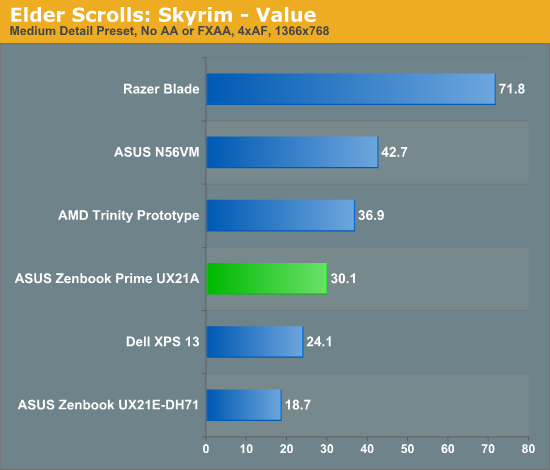
The 61% increase in performance over the original Zenbook takes the Prime into the realm of playability at these settings.

Portal 2 is an interesting case as we are significanty CPU and thermal bound here. The Prime can reach frame rates as high as 39 fps, but after a couple of runs you see degradation into the 32 - 37 fps range. On average, there's no improvement in performance compared to its predecessor - there's no beating the laws of physics.
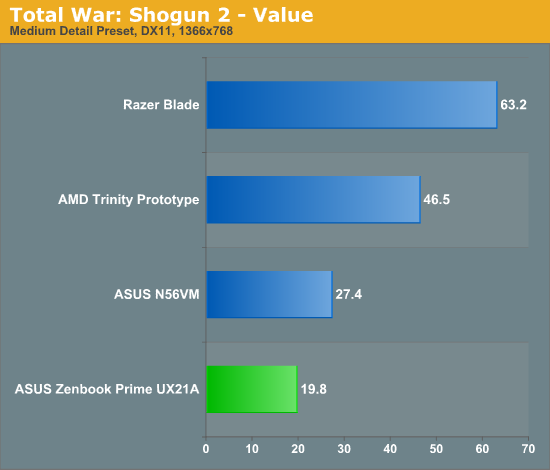
Diablo III
Last week Intel proudly showed me a demonstration of Diablo III running on Ivy Bridge's processor graphics, from a standard notebook all the way down to an Ultrabook. Eager to repeat the experiment myself, I fired up Diablo III on the Zenbook Prime.
Default settings at 1920 x 1080 were understandably unplayable. Dropping the resolution down to 1366 x 768 and clutter density down to medium however gave me an average of around 17 fps outdoors and 20 fps in early crypts. Given that Diablo isn't a twitch shooter, these frame rates were actually playable - all I needed was an external mouse.
As a primary gaming system, any Ultrabook this size is going to fall short. However, if you need to get your Diablo fix in while on the road, the Zenbook Prime will deliver in a pinch.



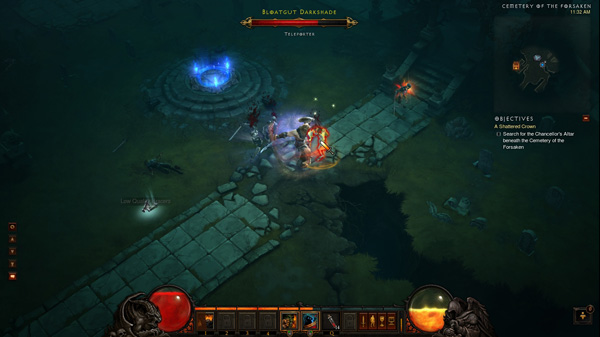








192 Comments
View All Comments
netmann - Saturday, June 9, 2012 - link
Anand did not open the bottom panel of UX21A this time around! But, I am curious to see if the SanDisk U100 is still the Gum Stick or the mSATA form factor. The SanDisk website does not show the Gum Stick type, only the mSATA and mini mSATA!If the SSD in UX21A is mSATA it can easily be upgraded with faster one such as Mushkin Atlas mSATA SSD. If U100 is Gum Stick perhaps it can be swapped with A-Data XM11 from previous Zenbook laptops or perhaps Runcore Rocket Air SSD. Your thoughts?
amosbatto - Sunday, June 10, 2012 - link
In GNU/Linux, you don't have the DPI scaling problem in menus, since its desktop environments let you set any font type and font size you want. Windows doesn't let you configure hardly anything.Anyone have any idea how well GNU/Linux supports this hardware? Since it is mostly stock Intel parts, I suspect that processor and graphics support is pretty good, but it would be nice to know if things like switchable TDP are possible. More importantly, does suspend and hibernate work correctly? How is the battery life in GNU/Linux.
And then there is the problem of touchpads, webcams, special buttons, etc. It would be really nice if review sites would list all the internal parts so we can google them and figure out what is supported in GNU/Linux, BSD, Haiku, etc. Not everybody likes to live in proprietary prisons.
amrs - Tuesday, July 31, 2012 - link
There are some issues with Linux but seem to be fixes too. Seems usable to me.See http://ubuntuforums.org/showthread.php?t=2005756 for discussion and https://help.ubuntu.com/community/AsusZenbookPrime for a wiki about the issues and fixes.
memin1857 - Friday, June 15, 2012 - link
I got the UX31A today and it has the 256GB ADATA XM11 Sandforce SSD! the package has the Sandforce Driven by LSI sticker. Also on the aliminium case. The model is UX31A-R4003V Turkish model with i7 cpu, FHD IPS Panel and 256GB SSD. I do not know if sandisk versiona exist. It was a nice surprise, I was worries about Sandisk U100 but it turns out to be Adata Sandforce :)netmann - Sunday, June 17, 2012 - link
Congratulation memin1857!I am also thinking of getting the UX31A or UX21A, however these are not available in US just yet! I currently own the UX31E. Did you get a chance to open the back panel to check the SSD in your UX31A? I am interested to know if your 256 GB ADATA XM11 is still a gum-stick format or a standard mSATA format. I am thinking of swapping the XM11 in my UX31E with the possible U100 in the A series laptops.
ilkhan - Saturday, June 23, 2012 - link
Swap the mini-VGA for a thunderbolt connector, remove the micro-HDMI and power LED for a full sized HDMI port.Fit a Gbit port on there somewhere or at least a bottom connected docking station with power/video/GBit/Sound.
Add a haswell quad CPU and a time appropriate midrange nVid GPU.
I'll get one next year.
Zodryn - Wednesday, July 4, 2012 - link
I recently received my ux31a from Amazon, and noticed a few interesting things:1) There are only two options in the configurable tdp section. 1.7GHz and 1.0GHz at 13W. There is no 16 or 17W option. This bothers me, as I was hoping for better gaming performance than my old ux21e, but at 13W, it was virtually the same. I could really use that extra bump. Anyone know why this is the case?
2) Adata SSD! This laptop is lightning fast. I attribute a good chunk of its speed to Sandforce.
3) When I have the brightness set to max, it is sometimes quite dim. It randomly and gradually brightens at times until it is very bright and pleasant to look at even in direct sunlight. It seems to have issues staying at a consistent brightness.
As a final note, my old ux21e (sandforce) boots in 16 seconds consistently. The ux31a (also sandforce), boots in 26 seconds consistently. This confuses me greatly.
yatahaze - Friday, August 3, 2012 - link
I've had a UX31A for a little over a month now, and my drive has gone horribly corrupt simply after waking it from sleep. Many many many errors reported by disk utilities.veteran_n00b - Thursday, August 23, 2012 - link
This just happened to me this morning. Tried to wake from sleep but the system was unresponsive. Forced shutdown and then it would not boot. I was able to get it going again with boot repair. Then I ran chkdsk the system file checker and found that there were a lot of corrupted files!Oh yeah, this is my 2nd laptop which I am in the process of returning because the webcam stopped working. My first one stopped charging one day so I had to return that.
I really want to like this laptop but wow, such quality issues!
ijozic - Tuesday, August 21, 2012 - link
I guess the review needs some update regarding the Ivy Bridge CPUs and the battery life in the low power mode, etc.